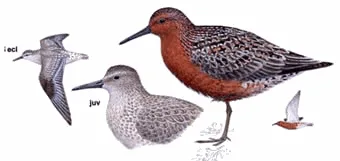
Red Knot
[order] CHARADRIIFORMES | [family] Scolopacidae | [latin] Calidris canutus | [UK] Red Knot | [FR] Becasseau maubeche | [DE] Knutt | [ES] Correlimos Gordo | [NL] Kanoetstrandloper
Subspecies
| Genus | Species | subspecies | Breeding Range | Breeding Range 2 | Non Breeding Range |
| Calidris | canutus | NA, EU | n | SA, Europe, AF, AU | |
| Calidris | canutus | canutus | nc Siberia | w and s Africa | |
| Calidris | canutus | islandica | islands off n Canada, n Greenland | w Europe | |
| Calidris | canutus | piersmai | New Siberian Arch. | to nw Australia | |
| Calidris | canutus | rogersi | Chukotsk Pen. (e Siberia) | Australasia | |
| Calidris | canutus | roselaari | Wrangel I. (ne Siberia), nw Alaska | shores of the Gulf of Mexico | |
| Calidris | canutus | rufa | n Canada | to s South America |
Physical charateristics
Red Knot is a plump, medium-sized shorebird with a fairly short bill. In breeding plumage, its face and underparts are a rich chestnut red. Its upperparts are primarily dark, with some spersed rufous fringing. In winter plumage, the red Knot is plain gray above. Rump and lower back pale gray, blending with tail. Underparts dull white with some dark vertical streaking on upper breast that may extend to the flanks. In breeding plumage female has light-colored feathers amongst the belly feathers and less distinct eyeline. Sexes appear similar in winter. Female has slightly longer wings and bill.
Listen to the sound of Red Knot
[audio:http://www.aviflevoland.nl/sounddb/R/Red Knot.mp3]
Copyright remark: Most sounds derived from xeno-canto
| wingspan min.: | 47 | cm | wingspan max.: | 53 | cm |
| size min.: | 23 | cm | size max.: | 26 | cm |
| incubation min.: | 21 | days | incubation max.: | 22 | days |
| fledging min.: | 18 | days | fledging max.: | 22 | days |
| broods: | 1 | eggs min.: | 3 | ||
| eggs max.: | 4 |
Range
North America, Eurasia : North
Habitat
Breeds in drier tundra areas, such as sparsely vegetated hillsides. Outside of breeding season, it is found primarily in intertidal, marine habitats, especially near coastal inlets, estuaries, and bays.
Reproduction
On the breeding grounds, males perform a courtship display in which they fly in high circles above their territory, hover on quivering wings, and then glide through the air while giving mellow calls. They also display on the ground by holding their wings high above the body. Red Knot nests on the ground, creating a shallow, lined scrape on the tundra. A typical clutch contains three to four eggs, and is incubated by both sexes for about three weeks. The downy chicks leave the nest shortly after hatching, and are able to feed themselves. Both parents provide care immediately after hatching, but the female leaves the young before they are fully independent at about three weeks of age.
Feeding habits
On its Arctic breeding grounds, it prefers high, barren, inland areas, often near a pond or stream. When first arriving in the Arctic, Red Knot eats a substantial amount of plant material; it then switches to a primary food supply of insects as they become more plentiful later in the season. Small invertebrates such as mollusks, marine worms, and crustaceans are major food sources in migration and winter. During spring migration along the Atlantic Coast of the U.S., the species relies heavily on the eggs of horseshoe crabs, which are deposited in the billions along sandy beaches. On the breeding grounds, Red Knot forages for insects mostly by sight, but when feeding on tidal mudflats, it forages mostly by touch, probing for marine invertebrates
Conservation
This species has an extremely large range, and hence does not approach the thresholds for Vulnerable under the range size criterion (Extent of Occurrence <20,000 km2 combined with a declining or fluctuating range size, habitat extent/quality, or population size and a small number of locations or severe fragmentation). Despite the fact that the population trend appears to be decreasing, the decline is not believed to be sufficiently rapid to approach the thresholds for Vulnerable under the population trend criterion (>30% decline over ten years or three generations). The population size is extremely large, and hence does not approach the thresholds for Vulnerable under the population size criterion (<10,000 mature individuals with a continuing decline estimated to be >10% in ten years or three generations, or with a specified population structure). For these reasons the species is evaluated as Least Concern.

Migration
Long distance migrant, with relatively few stopover sites. Race islandica, from Canada and West Greenland, crosses Greenland icecap, North Atlantic, often Iceland (probably not used by birds from Greenland), to Northwest Europe; some move down SW Norway and Denmark, mainly juveniles, only in autumn; spring migration more synchronized, passing through Iceland and North Norway. Race canutus probably has 3 migration routes: birds from Yaktia perhaps move overland to Gulf of Finland, through Baltic and West Europe to West Africa (mainly Banc d
